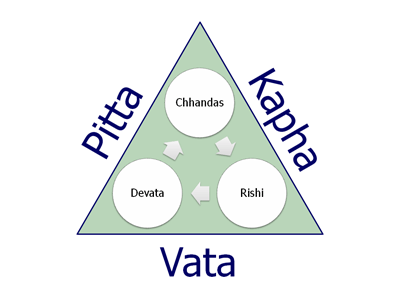Ayurveda Overview

Ayurveda Amritanam: Ayurveda is for Immortality
Ayurveda (Sanskrit for the Science of Life) gives timeless and profound knowledge of how to optimize health and longevity. It is the original owner’s manual for the human body. It explains our individual differences and how to harmonize with them to maintain balance, improve vitality, and resist disease primnarily through through choices of diet and lifestyle.
Ayurveda has been maintained in India as an oral tradition for countless generations. The stream of Ayurvedic knowledge is visible in the healthcare heritage of other countries including China, Greece and the Arab world. The Shushruta Samhita is the world's oldest textbook of surgery. Other traces of Ayurvedic practices could still be found in western medicine at the time I trained in Family Medicine.
Ayurveda is not simply a tradition of medicine. It is grounded in a comprehensive understanding of the individual in relation to the cosmos. The Vedas describe the entire galactic universe as an expression of Consciousness. This starkly contrasts with the western view that consciousness is an emergent property of inert matter. From the Ayurvedic perspective, the body is effectively a machine for creating consciousness from food. Thus, the qualities of the food we eat, how we eat it and the power of our digestion profoundly influence both body and mind.
Moreover, the purpose of Ayurveda is to reconnect individual life to its source in the perfect value of Veda. Veda represents total knowledge, the blueprint of creation, the constitution of the universe, and the source of all the Laws of Nature. Veda is found beyond space, time and change in the field of Transcendental Consciousness, also known as Atma (our higher Self, the Self of everyone). The fully blossomed experience of Atma reveals it to be Sat-Chit-Ananda (Pure Bliss Consciousness), eternal and unchanging. In other words, Ayurveda is for enlightenment: for the bliss of higher consciousness and liberation from the ever-present potential for suffering inherint to the field of relative existence. In enlightenment, we find the immortality in our own Consciousness nothwithstanding the finitude of the physical body.
Ayurveda is Not Man-Made

Ayurvedic knowledge first flowed from the cognitions of ancient Seers who discovered the Vedas within the settled state of their own self-referral awareness. Unlike modern medicine, Ayurveda is not man-made. It is an expression of fundamental truths of life open to reaffirmation by anyone.
Among many other things, these cognitions of the Vedas describe the mechanics of creation of our manifest universe from the eternal, unchanging unified field of Absolute Pure Consciousness. Wholeness becoming aware of itself gives rise to three primary values even while remaining unified and unexpressed: the knower (Rishi), the process of knowing (Devata) and the object of knowledge (Chhandas). This movement of Wholeness within itself gives rise to the structure of Veda and to the appearance of progressively "denser" layers of creation. Fundamentally, we are the expression of Veda. Vedic Science reveals how the Vedas and the Vedic literature are expressed in our physiology.
Three Doshas Govern Human Life
At the finest level of the manifest creation, which can be equated to the world of Quantum Mechanics, are found the three Doshas - Vata (movement), Pitta (metabolism) and Kapha (structure). While the word Dosha may be translated as impurity, the Doshas are impure only in the sense that they are differentiated from Veda or Wholeness. They emerge from the junction points between Rishi, Devata and Chhandas. Being subtle and mobile, Vata leads the other Doshas and is most prone to going out of balance. It primarily governs bodily functions related to movement. Pitta governs digestion and metabolism. Kapha governs structure. Vata and Kapha are fundamentally opposites. All they have in common is the quality of coldness. All heat comes from Pitta.

The Doshas interact and give rise to the five subtle, primordial elements (the Mahabhutas): Space (Akashya), Air (Vayu), Fire (Agni), Water (Jal) and Earth (Prithivi). These elements correspond to the five objects of sense organs (the Tanmatras): Hearing (Shabda), Touch (Sparsha), Sight (Rupa), Taste (Rasa) and Smell (Ghanda). They also correspond to the five sense organs (the Gyanendriya) and the five organs of action (the Karmenendriya): ears and speech, skin and arms, eyes and legs, tongue and excretory organs, and nose and reproductive organs.
While the Doshas control the deepest level of human physiology and the material creation, their qualities and effects can be readily observed. This is a boon since the key to health is maintaining balance of the Doshas in the face of the constant change which characterizes our physical existence. Once we know how to look for these qualities, it becomes easier to make healthy choices.
Three Gunas Make the World Go Around
While the three Doshas are central to Ayurveda, the Three Gunas, known as Sattva, Rajas and Tamas, also play an important role as their interactions govern the entire field of change. With respect to human physiology, they are sometimes called the Mental Doshas because their influence is most prominent at that level. For optimum health, happiness, vitality, immunity, longevity and spiritual progress, cultivate Sattva.
Principles of Therapy
Through our choices and behaviors today, we make our tomorrow. All disease can be seen to arise from violations of the laws of nature at some recent or remote time in the past (see: Jyotish). Considering the complexity of life, it's all too easy to make mistakes in our diet, choice of sensory inputs, daily routine, thoughts, speech and actions. Ayurveda offers knowledge of how to correct imbalance, reconnect to the source of life, and live in accord with natural law. While it places great emphasis on diet and daily routine, it acknowledges that the single most powerful technology for improving health is direct contact with the field of Pure Consciousness. For this reason, I frequently advise my clients to learn Transcendental Meditation. TM is a simple, natural technique to take the awareness to the field of Pure Consciousness and spontaneously align with the laws of nature. The profound effects of regular TM practice have been documented in hundreds of scientific studies (see Research on TM for references). I find that those who meditate regularly have an easier time making health-enhancing changes in diet and daily routine. In addition, they have greater resistance to the stress of everyday life.
Food as Medicine
Ayurveda also includes detailed knowledge of how to harvest, prepare and use herbs, both to restore balance (therapy) and to promote longevity (Rasayana). A classic Ayurvedic aphorism intentionally over-dramatizes their potential limitation:
Without proper diet and routine, medicines are of no use. With proper diet and routine, medicines are of no need.
For this reason, I am conservative in my recommendations for herbal therapy to treat imbalances. Although herbs can be highly beneficial, it makes little sense to take a bath and then roll in the mud. Often, simple changes in diet and routine will suffice. Such changes may also prove to be essential to protect long term health. On the other hand, for those enjoying good health, I strongly advocate Rasayana therapy along with seasonal detoxification to protect health and promote longevity. Even when I recommend herbs to achieve specific aims, I prefer to use those that have Rasayana value.
Traditional Vedic herbs are whole foods that are collected and processed so as to retain their full inner intelligence. They are not synthetic chemicals. In accord with the science of Samyoga, they are given in synergistic combinations which increase bioavailability, enhance effectiveness and minimize unwanted side-effects. In contrast, the fragmented approach of western pharmacology commonly seeks to develop drugs that target specific receptors in the body: think beta-blockers, ACE-inhibitors and statins. Such drugs, as helpful as they can be, are "poisons" by design and invariably carry risk of side-effects, not to mention adverse interactions with other drugs.
Ayurvedic remedies are safe if used as recommended and obtained from a reputable source that closely controls quality and tests to assure there has been no contamination with microbes or heavy metals like lead, mercury and arsenic. For this reason, I typically recommend herbal formulas from Maharishi Ayurvedic Products International, which were designed by leading experts. I have used MAPI products myself for many years with great benefit. If you order herbs or personal care products from Maharishi Ayurvedic Products (MAPI.com) using the links on my website, I will receive a 20% commission. Because MAPI has had problems with product availability, I also have established a relationship with Banyan Botanicals (banyanbotanicals.com). Their products are also trustworthy and produced to high standards. If you order their products using the links on my website, I will receive a 15% commission. You can get a one-time 15% discount by using this code: QATOQI15. Whether or not you use these links, the price you pay will be the same.
How to Learn More About Ayurveda
You will find lots of information on my website. If that doesn't satisfy your thirst for knowledge, consider the Personal Wellness Course. Of the many books available on Ayurveda, here are the two I can wholeheartedly recommend to you:
- Living in Balance with Maharishi Ayurveda
- Practical Therapies for Consciousness-Based Health
- Robert Keith Wallace, Karin Pirc, Julia Clarke
- Dr. Wallace recruited me to teach at Maharishi International University. His landmark research on the physiological effects of meditation published in the prestigious journal Science and summarized in Scientific American was one of the catalysts that got me started with Transcendental Meditation in my first year of medical school. Julia is an articulate spokesperson for Ayurveda. She was the lead teaching assistant for my first class at MIU. Dr. Pirc and her husband have run the Maharishi Ayurveda Health Centre in Bad Ems, Germany since 1992. They transformed it into one of the world's premier health spas. She has extensive Ayurveda practice experience. This book covers all the basics of Ayurveda and how to apply it in daily life.
- Picture of Health
- Transform your self-care and health care through Ayurveda and Integrative Medicine
- Charles Elder, Leslie Elder
- I met Charles Elder teaching in the Masters of Ayurveda program at Maharishi International University. We became friends working a PhD development curriculum and from get togethers on my visits to family in Portland, OR. For many years he ran a thriving Integrative Medicine consultation service at Kaiser Permanente. He and his wife, Leslie, now run the Integative Medicine Fellowship for physicians and advanced practice providers at MIU. The book is filled with practical advice, recipes, and Leslie's artwork.
Resources
- Ayurveda Consultation Process
- Ayurvedic Vegetarian Cooking Classes
- Guided Grocery Shopping
- Group Lectures on Ayurveda
- Food and Health
- The Doshas
- The Three Gunas
- Vedic Science
- The Dhatus
- Ideal Daily Routine
- Managing Personal Change
- Balancing the Doshas
- Managing Indigestion
- Ama Reduction
- Home Detoxification
- Rasayanas - Elixirs for Health
- New Client Questionnaire
- Health Habits Assessment
- Ama Assessment
- Digestion Assessment
- Dosha Imbalance Assessment
- Dosha Assessment